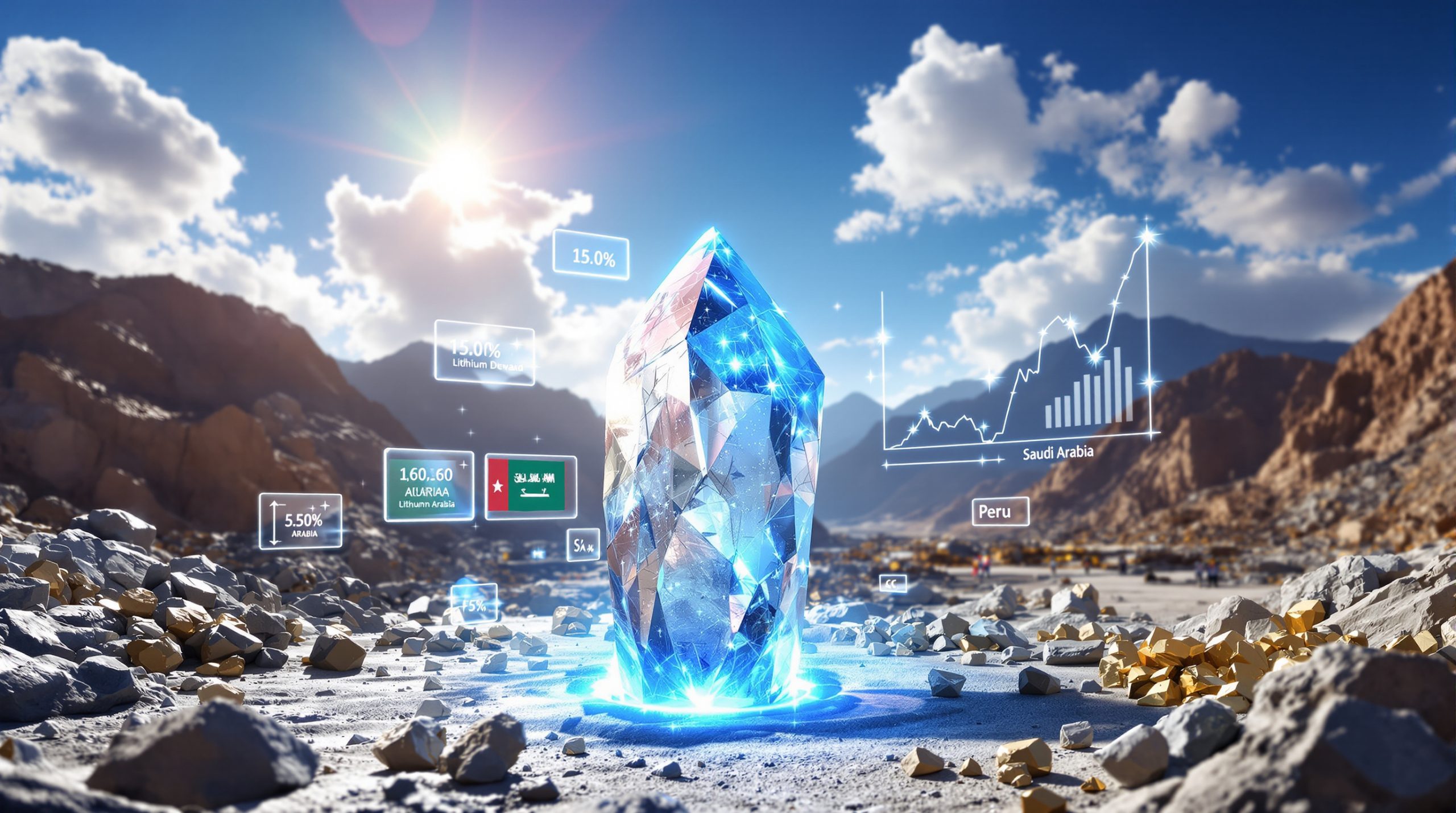US Rare Earth Expansion: Terra Uranium's Strategic Move Amid Critical Minerals Boom
The Strategic Partnership with Axiom Group
Terra Uranium (ASX: T92) has expanded its agreement with exploration services company Axiom Group to target rare earth element (REE) assets in the United States. This strategic move builds upon their existing collaboration in Canadian uranium exploration dating back to October 2024, when Terra signed option agreements over various assets with ATHA Energy.
Axiom brings specialized expertise in North American REE and antimony sectors, offering comprehensive geological field and mineral exploration services through every phase of exploration. The company has established a leadership position in Canada's Athabasca Basin and maintains strong involvement across multiple critical mineral sectors.
"We feel that we have the right team, technical expertise, resources and presence to assist Terra to drive its US critical minerals strategy," explained Axiom Group Chief Executive Officer Doug Engdahl in a recent statement about the partnership expansion.
US Government's Critical Minerals Strategy
Terra's expansion into the US rare earth market aligns perfectly with Trump's critical minerals policy. The strategic timing of this move positions Terra to capitalize on unprecedented levels of federal investment in critical minerals development.
Terra's non-executive director Niv Dagan highlighted this expansion as a response to "a truly fundamental shift in how America secures critical minerals," noting that the company is witnessing "both government and private investment backing at a level that hasn't been seen before, where governments are taking equity stakes in some of the world's largest companies."
This assessment reflects a significant evolution in US resource security policy, with critical minerals now receiving priority treatment comparable to strategic defense assets.
How Significant is US Government Investment in Rare Earth Elements?
Recent Federal Funding Initiatives
The scale of US government investment in rare earth elements has reached historic levels in 2025. Reports emerged earlier this month that the Trump administration is considering redirecting more than $3 billion from the CHIPS Act (Creating Helpful Incentives to Produce Semiconductors and Science Act) to support domestic critical minerals initiatives.
This potential reallocation follows an announcement from the Office of Manufacturing and Energy Supply Chains, which revealed plans to offer approximately $770 million in funding to expand US critical minerals and materials processing, along with battery manufacturing and recycling capabilities.
These announcements represent part of a broader pattern of increasing federal support for rare earth and critical minerals development, creating a favorable environment for companies like Terra Uranium to pursue strategic acquisitions and development opportunities.
Strategic Defense Investments
The Pentagon has also stepped up direct investment in rare earth element projects, recently committing $610 million to MP Materials to secure America's only current rare earth supply chain project. This investment underscores the national security dimensions of rare earth element production and processing.
What makes this wave of investment particularly notable is the shift toward government equity participation in strategic minerals companies. Rather than simply providing grants or subsidies, federal agencies are increasingly taking ownership stakes in critical minerals projects, reflecting the essential nature of these resources for national security and economic competitiveness.
Why Are Rare Earth Elements Considered Critical to US Interests?
Supply Chain Security Concerns
The current global REE supply chains are heavily concentrated in a small number of countries, creating strategic vulnerabilities for the United States and other Western nations. China currently dominates rare earth mining, processing, and magnet manufacturing, controlling approximately 80% of global rare earth oxide production.
This concentration of supply chain control has prompted the US government to work actively toward reducing dependency on foreign sources for these strategic materials. Recent geopolitical tensions have highlighted the risks of relying on potentially unstable or adversarial nations for materials essential to defense systems and advanced technologies.
Domestic production capabilities are increasingly viewed as essential for national security and technological sovereignty, with rare earth elements representing a cornerstone of modern military systems and energy transition in minerals.
Industrial and Technological Applications
Rare earth elements comprise 17 metallic elements that, despite their name, are relatively abundant in the Earth's crust. However, they rarely occur in concentrated, economically viable deposits. These elements possess unique magnetic, luminescent, and electrochemical properties that make them irreplaceable in numerous high-tech applications.
Key applications for rare earth elements include:
- Defense systems and military hardware (guidance systems, radar, night vision technology)
- Renewable energy technologies (permanent magnets for wind turbines, electric vehicle motors)
- Advanced electronics and communications systems (smartphones, computer hard drives)
- Medical equipment and diagnostic tools (MRI machines, lasers)
The growing demand for these technologies, particularly those supporting decarbonization efforts like electric vehicles and wind energy, has intensified competition for reliable rare earth supplies, driving governmental interest in securing domestic sources.
What Makes Terra Uranium Well-Positioned for US Rare Earth Exploration?
Leveraging Existing Expertise
Terra's expanded agreement with Axiom builds on their established partnership in the uranium sector, allowing them to apply existing exploration methodologies and geological expertise across different critical mineral categories. This approach enables Terra to pursue rare earth opportunities while maintaining its core competencies in uranium market trends.
The technical synergies between uranium and rare earth exploration create efficiencies in resource allocation and expertise development. Both mineral categories often require specialized geological knowledge, radiometric surveying techniques, and experience with regulatory frameworks for radioactive materials.
Axiom's Chief Executive Officer Doug Engdahl emphasized their capabilities, noting: "We have the right team, technical expertise, resources and presence to assist Terra to drive its US critical minerals strategy." This statement reflects confidence in the partnership's ability to identify and develop promising rare earth assets in the United States.
Strategic Timing
Terra's entry into the US REE market coincides with unprecedented levels of government investment, positioning the company to benefit from favorable regulatory and funding environments. The current administration's focus on domestic critical minerals strategy pivot creates multiple potential pathways for project acceleration and support.
This expansion represents a diversification strategy beyond Terra's existing uranium focus, allowing the company to balance its portfolio across multiple critical mineral categories while capitalizing on growing market demand for rare earth elements. The timing aligns with increasing recognition of rare earth elements as strategic national assets rather than conventional commodities.
How Does This Fit into the Global Critical Minerals Landscape?
International Competition for Rare Earth Resources
Major economies worldwide are racing to secure reliable REE supplies, with the United States, European Union, Japan, and Australia all implementing strategic initiatives to reduce dependence on Chinese supply chains. This global competition has intensified as demand for advanced technologies and clean energy solutions continues to grow.
The US strategy represents part of a broader international effort to diversify and secure critical mineral supply chains. Recent years have seen increased collaboration between allied nations, with agreements like the US-Australia Critical Minerals Agreement establishing frameworks for joint development of resources and processing capabilities.
Terra's expansion occurs against a backdrop of increasing geopolitical tensions around critical mineral supply chains, with resource nationalism and strategic stockpiling becoming more common practices among major economies.
Market Outlook for Rare Earth Elements
Demand for rare earth elements is projected to grow significantly due to the clean energy transition and technological advancement. Industry analysts project global rare earth magnet demand to increase by 7-8% annually through 2030, driven primarily by electric vehicle production and wind turbine installations.
Supply constraints are expected to persist, potentially creating favorable pricing environments for new market entrants. The development timeline for new rare earth projects typically spans 5-10 years from discovery to production, creating opportunities for companies with early-mover advantage in favorable jurisdictions.
Companies with early-mover advantage in domestic US production could secure strategic positioning in what promises to be an increasingly competitive market. The combination of growing demand, supply chain concerns, and government support creates a potentially favorable environment for Terra's US rare earth strategy.
What's Next for Terra Uranium's US Rare Earth Strategy?
Exploration and Acquisition Targets
Terra and Axiom are actively seeking US-based REE opportunities, with a focus on regions known to host favorable geological formations for rare earth mineralization. The partnership will leverage Axiom's existing involvement in the North American REE sector to identify promising prospects.
Target assets will likely align with US government priorities for domestic critical minerals development, focusing on deposits that contain magnet rare earth elements like neodymium, praseodymium, dysprosium, and terbium. These elements command premium pricing due to their essential role in high-strength permanent magnets used in electric vehicles and wind turbines.
The company's exploration strategy will need to balance geological potential with practical considerations like proximity to infrastructure, permitting pathways, and processing options. Unlike many conventional minerals, rare earth elements require specialized processing facilities to separate individual elements from ore concentrates.
Potential Development Timeline
The initial exploration and asset identification phase is currently underway, with Terra and Axiom evaluating potential acquisition targets across multiple US regions. Following successful target identification, the company would likely proceed with preliminary geological assessment and resource definition work.
Development timelines will depend on specific project characteristics and permitting processes, with most rare earth projects requiring 3-5 years of exploration and feasibility work before development decisions. The complexity of rare earth processing adds additional technical considerations to project development pathways.
The company will need to navigate complex regulatory environments for critical minerals projects, balancing federal support with state and local permitting requirements. However, the current administration's focus on expediting critical minerals development may create opportunities for streamlined permitting processes in the US uranium market dynamics.
FAQ: Terra Uranium's US Rare Earth Expansion
How does Terra Uranium's rare earth strategy complement its uranium business?
Terra's expansion into rare earth elements represents a strategic diversification within the critical minerals sector. Both uranium and rare earth elements are considered critical minerals with similar exploration methodologies and regulatory frameworks. This allows Terra to leverage existing expertise while expanding its portfolio of strategic resources.
The technical synergies between uranium and rare earth exploration enable efficient resource allocation and expertise development. Both mineral categories often involve similar geological settings, radiometric surveying techniques, and specialized regulatory knowledge, creating operational efficiencies.
What advantages does the Axiom partnership bring to Terra's US expansion?
Axiom Group provides Terra with established expertise in North American rare earth exploration, comprehensive geological services, and an existing presence in the US market. This partnership reduces entry barriers and accelerates Terra's ability to identify and develop promising rare earth assets in the United States.
The collaborative relationship, built through their existing uranium exploration work, provides a foundation of trust and operational efficiency that would be difficult to replicate with a new partner. Axiom's specialized knowledge of the North American REE sector provides Terra with market intelligence and technical capabilities essential for successful project identification.
How might government funding impact Terra's development timeline?
The unprecedented levels of US government investment in critical minerals could potentially accelerate project development through direct funding, streamlined permitting, or public-private partnerships. This supportive environment may reduce capital requirements and development timelines compared to traditional mining projects.
Government equity participation in critical minerals projects represents a particularly significant development, potentially reducing financing risk and providing additional validation for project economics. Companies with projects aligned with national security priorities may benefit from expedited permitting processes and technical support from national laboratories.
What are the key challenges for new entrants in the US rare earth market?
Despite favorable government policies, new entrants face significant challenges including complex extraction and processing requirements for rare earth elements, environmental permitting hurdles, and competition from established players. Companies must also develop strategies for the entire value chain, from mining to separation and processing.
The technical complexity of rare earth processing represents a particular challenge, as economically viable separation of individual rare earth elements requires specialized facilities and expertise. Building complete supply chains within US borders will require significant investment in processing infrastructure beyond simple mining operations.
Ready to Spot the Next Major Mineral Discovery?
Discover how investors can gain immediate insights into significant ASX mineral discoveries through Discovery Alert's proprietary Discovery IQ model, which transforms complex data into actionable opportunities. Explore why historic discoveries can generate substantial returns by visiting the Discovery Alert discoveries page and begin your 30-day free trial today to position yourself ahead of the market.




